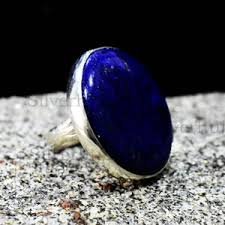


Lapis Lazuli is a precious stone with an intense blue color with pyrite inclusions, a mineral with a similar appearance to gold.
Those who appreciate the jewels and the blue color cannot fail to refer to this gemstone. The best deposits of Lapis Lazuli are found in Afghanistan, also mentioned by Marco Polo in his book "La Via della Seta".
The ancient Egyptian dynasties called this gem the "Stone of Heaven" because they constantly used it in their sacred art.
Torrini uses cabochon cut or polished Lapis Lazuli for its jewelry.

In addition to lazurite, specimens of lapis lazuli usually contain calcite and pyrite. Sodalite, hauyne, wollastonite, afghanite, mica, dolomite, diopside, and a diversity of other minerals might also be present. To be called "lapis lazuli," a rock must have a distinctly blue color and contain at least 25% blue lazurite.
Calcite is often the second most abundant mineral present in lapis lazuli. Its presence can be very obvious, appearing as white layers, fractures, or mottling. It can also be finely intermixed with lazurite to produce a rock with a faded denim color.
Pyrite usually occurs in lapis lazuli as tiny, randomly spaced grains with a contrasting gold color. When abundant, the grains can be concentrated or intergrown into distinct layers or patches. It can occasionally occur as a fracture-filling mineral.

As a rock, lapis lazuli is composed of several minerals, each with its own hardness, cleavage/fracture characteristics, specific gravity, and color. Hardness ranges from a Mohs 3 for calcite to the 6.5 of pyrite. The hardness of the material depends upon where you test it.
Lapis lazuli forms near igneous intrusions where limestone or marble has been altered by contact metamorphism or hydrothermal metamorphism. In these rocks, lazurite replaces portions of the host rock and often preferentially develops within certain bands or layers.

An even royal blue is the optimal colour for Lapis Lazuli. Uneven colour or hints of green will generally negatively affect the gem's beauty and value. Lapis Lazuli's colours can be broken down into three classifications according to Persian treatises: nili (dark blue), assemani (light blue) and sabz (green). While some prefer Lapis Lazuli that is a solid pure azure, the presence of flicks of Pyrite is desired by many. If there are too many Calcite or Pyrite eye-visible inclusions, the Lapis Lazuli is of lesser value.
As with all gems, cut quality is also a consideration and Lapis Lazuli comes in every cut imaginable. It can be difficult to find solid blues, and pieces between 10 to 20 carats in size are considered exceptionally rare.